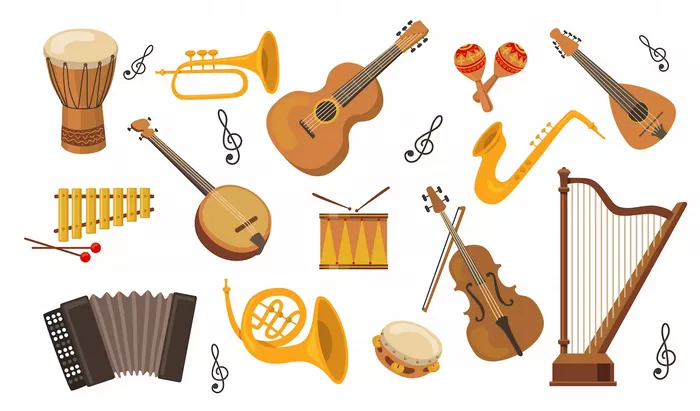Music is a universal language that transcends boundaries and connects people across cultures and generations. At the heart of music lies a diverse array of musical instruments, each contributing its own unique timbre and character to the rich tapestry of sound. From the delicate trill of a flute to the thunderous resonance of a grand piano, every instrument plays a crucial role in shaping the emotional landscape of a musical composition. In this article, we delve into the significance of each musical instrument, exploring their historical origins, technical capabilities, and cultural significance.
Piano: The Versatile Virtuoso
The piano stands as a cornerstone of Western classical music and remains one of the most versatile and widely used instruments across genres. With its vast range, dynamic expression, and harmonic richness, the piano holds the ability to evoke a wide spectrum of emotions, from the gentle melancholy of a nocturne to the exuberant energy of a concerto. Its invention in the early 18th century by Bartolomeo Cristofori revolutionized music-making, providing composers and performers with an instrument capable of both melody and accompaniment. The piano’s polyphonic capabilities enable musicians to explore complex harmonies and textures, making it an indispensable tool for composers seeking to express intricate musical ideas. Moreover, its presence in concert halls, classrooms, and living rooms around the world has made it a symbol of musical literacy and cultural refinement.
Violin: The Voice of Emotion
The violin, often hailed as the king of orchestral instruments, possesses a unique ability to communicate the deepest sentiments of the human soul. Its expressive range, from delicate whispers to impassioned cries, allows performers to convey a myriad of emotions with unmatched clarity and intensity. Dating back to the Renaissance period, the violin has evolved into a virtuosic instrument capable of dazzling displays of technique and artistry. Its prominence in classical music repertoire, from solo concertos to string quartets, highlights its versatility and enduring appeal. Beyond classical music, the violin’s evocative timbre has found its way into a variety of musical genres, including folk, jazz, and rock, demonstrating its universal appeal and timeless allure.
Guitar: The Icon of Popular Music
The guitar holds a special place in the annals of music history as the quintessential instrument of popular music. Its portability, accessibility, and versatility have made it a staple of virtually every musical genre, from blues and country to rock and pop. With its six strings and fretted fingerboard, the guitar offers endless possibilities for chordal accompaniment, melodic improvisation, and rhythmic propulsion. Whether strummed gently around a campfire or shredded with virtuosic speed on stage, the guitar possesses a unique ability to captivate audiences and inspire performers alike. Its role in shaping the sound of modern music cannot be overstated, as it continues to serve as a primary means of creative expression for musicians across the globe.
Flute: The Ethereal Enchanter
The flute, with its graceful tone and ethereal quality, has been enchanting listeners for centuries with its evocative melodies and delicate phrasing. Dating back to ancient civilizations such as Egypt and Greece, the flute has undergone numerous transformations in shape and construction, culminating in the modern concert flute found in orchestras and chamber ensembles today. Its ability to produce a wide range of colors and dynamics makes it a versatile instrument suitable for a variety of musical styles, from classical to contemporary. Whether floating above the orchestral texture or weaving intricate filigrees in a solo concerto, the flute possesses a magical quality that transports listeners to realms of beauty and imagination.
Drums: The Rhythmic Foundation
No musical ensemble is complete without the rhythmic propulsion and energy provided by the drums. From ancient tribal rituals to modern-day rock concerts, drums have served as the heartbeat of music, driving the pulse and setting the pace for performers and audiences alike. Their primal power and visceral impact evoke deep emotional responses, stirring the soul and igniting the spirit. Whether pounding out thunderous beats on a bass drum or dancing across the shimmering surface of a snare, drummers possess a special ability to unite disparate elements of melody and harmony into a cohesive musical whole. In addition to their role in providing rhythmic support, drums also serve as vehicles for creative expression, allowing performers to explore complex polyrhythms and improvisational techniques.
Saxophone: The Soulful Serenader
The saxophone, with its soulful tone and expressive range, occupies a unique place in the world of music as the embodiment of passion and emotion. Invented by Adolphe Sax in the 1840s, the saxophone was originally conceived as a versatile instrument capable of bridging the gap between brass and woodwind instruments. Its smooth, velvety timbre has since made it a favorite among jazz musicians, who prize its ability to convey the full spectrum of human emotion, from longing and melancholy to joy and exuberance. The saxophone’s prominence in popular music genres such as blues, funk, and rock further underscores its universal appeal and enduring legacy. Whether wailing plaintively in a smoky jazz club or soaring triumphantly over a big band ensemble, the saxophone possesses a raw emotional power that resonates deeply with listeners.
Trumpet: The Majestic Herald
The trumpet, with its bold, brassy tone and regal bearing, has long been associated with power, majesty, and celebration. Dating back to ancient civilizations such as Egypt and Mesopotamia, the trumpet has played a central role in ceremonial rituals, military processions, and festive occasions. Its piercing clarity and penetrating sound make it ideally suited for cutting through the din of battle or heralding the arrival of royalty. In addition to its ceremonial function, the trumpet has also carved out a prominent place in the world of music, featuring prominently in classical orchestras, jazz bands, and marching bands. Whether sounding a triumphant fanfare or weaving intricate melodic lines in a concerto, the trumpet commands attention and respect wherever it is heard.
Cello: The Soulful Songbird
The cello, with its rich, resonant tone and expressive depth, occupies a special place in the world of classical music as the embodiment of lyricism and emotion. Sitting at the heart of the string section, the cello serves as a bridge between the soaring melodies of the violins and the solid foundation of the basses, providing warmth, intimacy, and pathos to the ensemble sound. Its soulful timbre and expansive range allow performers to explore a wide variety of musical moods and emotions, from tender introspection to impassioned fervor. Whether singing sweetly in a solo sonata or blending seamlessly with the orchestra in a symphony, the cello possesses a unique ability to touch the hearts of listeners and evoke profound emotional responses.
Conclusion
Each musical instrument possesses its own unique qualities and characteristics that contribute to the rich tapestry of sound that is music. From the majestic herald of the trumpet to the soulful serenade of the saxophone, each instrument plays a crucial role in shaping the emotional landscape of a musical composition and connecting listeners to the deepest recesses of the human soul. Whether performing on stage or listening in the comfort of their own homes, audiences around the world continue to be captivated and inspired by the timeless beauty and enduring power of musical instruments. As we celebrate the diversity and richness of musical expression, let us remember the importance of each instrument and the vital role it plays in the world of music.

























